DECEMBER 16, 2020
 Monday, December 14, 2020 at 11:31AM
Monday, December 14, 2020 at 11:31AM HAPPY HOLIDAYS!
Enjoy our year-end issue, and we'll see you back here
on January 6, 2021!
BEST OF ON THE TABLE 2020
Editor's Note: Any news over the holiday break will be posted at the end of this column! -WG

(VW)
A year after officially announcing the end of the Beetle's production, Volkswagen produced a final tribute to the car. "Taking the celebration of life to the world stage," as VW's PR minions describe it, the Beetle will be honored in an animated short film called “The Last Mile,” which debuted during ‘Dick Clark’s New Year’s Rockin’ Eve with Ryan Seacrest 2020’ on ABC. According to Saad Chehab (then senior vice president, VW brand marketing), "While we chose the classic Beetle as the star of the animation, additional campaign components in Times Square honor the latter two generations of cars and their place and presence in American culture. We are proud of our past but our eye is on the future – hence our choice of New Year’s Eve to hint at our upcoming long-range EV and the 2020 Atlas Cross Sport.” Editor's Note: Well, alrighty then! While we like the animated short (produced by ad agency Johannes Leonardo), something seemed missing. It didn't feel heroic enough as a sendoff for this iconic vehicle. Maybe it was the use of animation (or maybe it's the ridiculous ending in which the Beetle flies away and turns into a bug)... it just didn't seem to capture the significance of the moment. -WG. Editor-in-Chief's Note: I concur, for the most part. On the one hand, kudos to VW for acknowledging the passing of the Beetle; on the other hand, the weirdness factor for weirdness sake is high. As in Not. Very. Good. And Saad Chehab's explanation for it all didn't add one scintilla of clarity to the whole thing. Nicely done! -PMD (1/8)

(The Peterson Automotive Museum)
The Petersen Automotive Museum debuted a new exhibit featuring ten custom vehicles donated from James Hetfield’s personal collection. The exhibit opened on February 1, in the Bruce Meyer Family Gallery. “Reclaimed Rust: The James Hetfield Collection” celebrated Hetfield’s creativity as a world-renowned artist through his built-from-scratch custom car collection, guitars, photos and memorabilia. Key vehicles on display included the 1948 Jaguar “Black Pearl” (above), the 1934 Packard “Aquarius,” the 1953 Buick Skylark “Skyscraper,” the 1937 Lincoln Zephyr “VooDoo Priest,” the 1936 Auburn “Slow Burn,” which were designed by famed builder and television personality, Rick Dore, as well as the 1936 Ford “Iron Fist,” the 1937 Ford Coupe “Crimson Ghost,” and the 1932 Ford Roadster “Black Jack.” Along with the custom vehicles, memorabilia displayed included an ESP Hollow Body guitar and a Mesa amplifier that are painted to match the Buick Skylark “Skyscraper,” images were displayed showing the build process of each car as well as a video of Hetfield talking about the cars. “'Reclaimed Rust’ brings together two industries that go hand in hand with artist expression,” said Petersen Automotive Museum Executive Director Terry L. Karges. “This is the first time the Hetfield collection will be showcased to the public and we can’t wait to share the inspiration behind these extraordinary vehicles with the world.” Hetfield is a lifelong car enthusiast and views his collection as a form of expression to convey his creativity. Hetfield’s vehicles assert both a reverence for history and a disregard for convention, standing collectively as a testament to the musician’s distinctive personality and artistic energy. The museum hosted a ticketed opening reception on January 30, 2020. The reception was highlighted by a ribbon cutting, a fireside chat with James Hetfield and an auction featuring two limited-edition ESP guitars. (1/15)

(Chevrolet)
Regular production of the 2020 Chevrolet Corvette Stingray coupe began on February 3, 2020, at General Motors Bowling Green Assembly in Bowling Green, Kentucky. Initial vehicle shipments to dealers began in late February. (2/5)

Introduced in 1989, the USA Today Ad Meter uses a large panel of viewers to rate all of the TV commercials that air during the Super Bowl. This year, there was an especially large number of automotive ads, so we thought it would be fun to conduct an "Ad Meter" of our own. We wondered whether the readers of Autoextremist – hard-core automotive enthusiasts, many of whom work in the auto industry – would view these ads differently than they are viewed by the general public.
The chart above shows how a group of 200 Autoextremist readers rated the eight auto commercials (blue line) and how these ads were rated by USA Today’s public panel (orange line). The numbers in orange show USA Today's Ad Meter rankings for the auto ads among all 62 ads that ran during the game. Despite the differences between these two groups (we are pretty sure that our AE readers are more knowledgeable and enthusiastic about automotive vehicles and are generally older and more affluent than the USA Todaygroup), and despite the fact that we used a different rating scale than the USA Today poll, you can see that our auto enthusiasts and the USA Today group gave these ads very similar overall ratings. Both groups gave the Jeep Gladiator and Hyundai Sonata commercials their highest ratings and Audi e-tron their lowest ratings. The only two major differences between the Autoextremist and USA Today readers were for the Jeep Gladiator ad and the GMC Hummer EV ad – in both cases, the Autoextremist readers rated these two ads much more positively than did the USA Today panel. It is not clear what these two differences are due to or what, if anything, they mean. Overall, it looks like automotive enthusiasts react to TV commercials about automotive vehicles very similarly to how the general public does.
We also looked to see if any of the various subgroups within the AE Ad Meter survey group differed in their reactions to the ad. We found a few statistically significant differences. Nearly two-thirds of our AE Ad Meter participants work (or have worked) in the auto industry (63% vs. 37% whose work is outside of the auto industry). Those working in the auto industry gave the poorly regarded Audi e-tron commercial a slightly more positive rating than those outside the industry.
Among the AE Ad Meter participants working in the auto industry, 58% work at one of the OEMs, 24% work at a supplier company, and 19% are affiliated with a dealership. The dealership folks rated the KIA Seltos commercial significantly higher than those working at automotive supplier companies. People from the dealerships also rated the Porsche Taycan commercial significantly lower than those working at either an OEM or one of the supplier companies.
We also looked at how people working in automotive marketing, advertising, and PR (either at an OEM or an agency) viewed the Super Bowl ads. These folks made up 20% of our auto industry group. We wondered if these consumer-messaging professionals would bring a different sensibility to their ad evaluations. They didn’t, with one exception. They rated the Hyundai Sonata commercial statistically significantly more positively than their colleagues working in other areas of the auto industry did.
Overall, it is interesting and potentially noteworthy that the bottom two auto ads on the USA Today Ad Meter were for EVs - the Audi e-tron and GMC Hummer EV - with the all-electric Porsche Taycan also scoring in the bottom four. (And except for the Hummer EV, the Audi and Porsche ads were judged harshly by AE readers as well.) Clearly, there are challenges to marketing EVs that go way beyond just selling consumers on a particular brand. Who will 'crack the code' and emerge a winner on the EV advertising front?
Thanks, once again, to Allen Bukoff for his survey and analysis. (And thanks to WordGirl too!) (2/5)
Editor-in-Chief's Note: The fact that Ford tried to pin responsibility for the company's dismal fourth quarter results on Joe Hinrichs was predictable and pathetic. And I am glad he told them to go pound sand. Joe is too good and has too much to offer to depart for the Land of Leisure just yet. Any number of companies could benefit from his talent and expertise. I will name one. If Elon Musk was as smart as he thinks he is, he'd offer the moon to Joe to come in and turn Tesla into a properly functioning car company - and then get the hell out of the way. But St. Elon's ego would never allow it. I will reiterate what I said in my column. Why is Hackett still there? And when Bill Ford hands the keys to the Kingdom to Farley after Hackett is retired, I fear for the future of the company. Knowledgeable, seasoned professionals have seen right through Farley's smarm offensive from the beginning. But Farley was smart enough to know that he only had two people to convince of his brilliance and that he was "the guy" - Hackett and Bill Ford. And it worked. Now, however, and to make things worse, we're going to be forced to endure an endless series of articles in the press that canonize Farley, which is a revolting development if there ever was one. Memo to the True Believers at Ford: Good night and good luck. - PMD (2/12)

(Rod Shows)
One of the Sacramento Autorama’s top awards (awarded on February 16th) was the King of Kustoms, which recognized the best 1935-1964 custom build with a focus on body lines, design, flow and quality of workmanship. This year’s winner was Glenn Black with his 1949 Mercury Custom. Judges particularly praised its incredible paint, which perfectly complemented its long swooping lines. We concur. (2/19)




A 1929 Duesenberg J-218 Town Limousine and 1973 Porsche 917/30 Can-Am Spyder were crowned this year’s Best in Show on March 8, 2020 at the 25th annual Amelia Island Concours d’Elegance. In celebration of the event's Silver Anniversary, the concours featured a special "homecoming" of alumni honorees. At the center of the celebration was famed racer, team owner and international businessman - "The Captain" - Roger Penske. The Duesenberg was once owned by Captain George Whittell Jr., heir to an impressive California gold rush and real estate fortune and the ultimate playboy of his day. Whittell Jr. famously liquidated his entire stock portfolio (approximately $50 Million at the time) just two weeks before the infamous stock market crash of 1929. A larger-than-life public figure in San Francisco society, Whittell engaged in numerous escapades with women, reckless street racing and outrageous public appearances. Whittell collaborated with Murphy Coachbuilders for a fleet of custom Duesenbergs. This distinctive Murphy bodied Town Limousine sports an aluminum roofline that allows the doors to be curved upward into the roof. This feature was carried forward into several future designs for Murphy. The most distinctive features of the J-218 were the angled windshield, surrounded by "clear vision" window pillars and the classic Art Deco paint scheme. The bare aluminum beltline was polished to a mirror finish to divide the black bottom from the white top. Chrome flashes such as the door hinges, tool and battery doors complete the look. Vent doors in the hood rather than louvers are also a special feature. (3/11)
 The famous Penske Racing 1973 Porsche 917/30 Can-Am Spyder owned by Rob Kauffman of Charlotte, North Carolina, took home the Best in Show Concours de Sport Trophy. "It is to me the perfect racing car," said Indy 500, Can-Am and Trans Am Champion Mark Donohue of Porsche's all-conquering 1500HP 917/30. It powered him to six victories in eight races in 1973, and to the Can-Am Championship. After nearly a half century the magnificent Porsche 917/30 is still the most powerful circuit racing car ever made. While no one knows the car's ultimate top speed it easily achieved speeds of over 200 mph at circuits like Road America, Watkins Glen and Riverside. It set a closed course speed record of 221.16 mph at Talladega Superspeedway in a special one-off effort in 1975. Now 50 years later, that remains the fastest lap ever recorded on the steeply banked superspeedway in Alabama. “The 1929 Duesenberg J-218 Town Limousine and 1973 Porsche 917/10 Can-Am Spyder both embody the spirit of our awards,” said Bill Warner, Chairman and Founder of the Amelia Island Concours d’Elegance. “The judges had a tough challenge in a field a cars that would win Best of Show at many other concours. I am pleased they did due diligence and continue to recognize the best and most extraordinary vehicles in existence, right here in Northeast Florida. (3/11)
The famous Penske Racing 1973 Porsche 917/30 Can-Am Spyder owned by Rob Kauffman of Charlotte, North Carolina, took home the Best in Show Concours de Sport Trophy. "It is to me the perfect racing car," said Indy 500, Can-Am and Trans Am Champion Mark Donohue of Porsche's all-conquering 1500HP 917/30. It powered him to six victories in eight races in 1973, and to the Can-Am Championship. After nearly a half century the magnificent Porsche 917/30 is still the most powerful circuit racing car ever made. While no one knows the car's ultimate top speed it easily achieved speeds of over 200 mph at circuits like Road America, Watkins Glen and Riverside. It set a closed course speed record of 221.16 mph at Talladega Superspeedway in a special one-off effort in 1975. Now 50 years later, that remains the fastest lap ever recorded on the steeply banked superspeedway in Alabama. “The 1929 Duesenberg J-218 Town Limousine and 1973 Porsche 917/10 Can-Am Spyder both embody the spirit of our awards,” said Bill Warner, Chairman and Founder of the Amelia Island Concours d’Elegance. “The judges had a tough challenge in a field a cars that would win Best of Show at many other concours. I am pleased they did due diligence and continue to recognize the best and most extraordinary vehicles in existence, right here in Northeast Florida. (3/11)
RUF Automobile GmbH, the Pfaffenhausen, Germany-based manufacturer and creator of bespoke sports cars that combine performance and suitability for everyday use, has unveiled the first production RUF SCR and something completely different, the RUF Rodeo Concept. The RUF SCR features a 4.0L normally aspirated flat-six engine producing 510HP with 470 Nm of torque and it weighs-in at 1,250 kg. The engine is mated to a six-speed manual gearbox and the car’s spoiler generates high downforce, keeping the RUF SCR stable at its top speed of 199 mph. The RUF Rodeo Concept was inspired by the Rodeo Drive Concours d’Elegance and its founder – and friend of RUF – Bruce Meyer, as well as by Ralph Lauren and his 2011 Western Collection, and RUF enthusiast and collector Phillip Sarofim who has roots in Texas. The car features the same carbon fibre monocoque chassis as the CTR Anniversary and the SCR, but with a four-wheel drive system to tackle off-road use, larger all-terrain tires, longer-travel suspension and more. The Rodeo Concept can accommodate either a normally aspirated or turbo-charged RUF flat-six engine. “When we began building our own automobiles it was all for the thrill of the drive,” said Estonia Ruf, marketing director of RUF Automobile GmbH. “The Rodeo Concept combines that passion for cars with the love of western culture – an appreciation I found while studying in Oklahoma. This car is inspired by some of our favorite people and our love for the countryside.” (3/11)







(GM)
Editor-in-Chief's Note: The 1961 Corvette Mako Shark I (XP-755) and 1965 Corvette Mako Shark II concepts photographed at the GM Technical Center in Warren, Michigan. The Mako Shark I was designed by Larry Shinoda under the direction of GM Styling legend Bill Mitchell. It was largely inspired by the 1959 Chevrolet Corvette Sting Ray racer which, of course, heavily influenced the 1963 Chevrolet Corvette Sting Ray production car. The Mako Shark II obviously influenced the 1968 Chevrolet Corvette Sting Ray production car. The inspiration for the paint on the Mako Shark concepts originated from Bill Mitchell, who caught a real one while fishing off the Gulf coast of Florida. He had the fish mounted on the wall of his GM Styling office, and insisted that his paint shop paint the Mako Shark I in gradations to match the colorization of his prized mounted Mako Shark. True story? After several attempts to paint the Mako Shark I concept, Mitchell was still not pleased, and the project ground to a halt because the paint wasn't "right" according to Mitchell. So, the next time Mitchell was away from the office on a trip, some ingenious designers had the idea of removing Mitchell's prized fish from the wall late one evening, and painting it exactly like the latest paint job on the Mako Shark I concept. Mitchell came back, and with no knowledge of what transpired, he pronounced the paint work on the Mako Shark I concept "perfect" and the concept headed to the show circuit. -PMD (3/25)
Editor's Note: Kudos to metro Detroit-based ad agency Doner for their new ad, ""When the Motor Stops," promoting the resilience and determination of the Motor City as it fights the COVID-19 pandemic. As reported by Julie Hinds in the Detroit Free Press, "the idea came from a young brand strategist, Alex DeMuth, (who said) 'Our agency can’t make ventilators or masks, but we can make content.'" The filming was done last Friday by one employee, who built a camera rig to fit on his car and drove through the city's deserted streets. He then edited it from home, while a copywriter recorded the narration from her closet. It is truly a great - and powerful - ad. -WG (4/1)
Editor-in-Chief's Note: Under Bill Mitchell's tutelage, GM did a lot of hot Corvair-based concepts. The first was the short-lived 1961 Corvair Sebring Spyder (in red), which was a mild custom, but it notably reflected Mitchell's love of open-top racing cars. That machine was followed by the 1962 Corvair Super Spyder concept, which was a dramatic departure from the production Corvair at the time. The Super Spyder (XP-785) was one of the most striking concepts from GM Styling during that era. Originally painted in Mitchell's favorite metallic silver (he loved the "Silver Arrow" Mercedes-Benz Grand Prix cars) the Super Spyder was a wild machine. It was shortened in length (171" vs. 180") and wheelbase (93" vs. 108") from the production Corvair (a 15" section was removed between the door and the rear wheel arches). The Super Spyder also bristled with race-oriented design details including a cut-down windscreen; aero mirrors; an aerodynamic headrest built into the long fiberglass rear deck; a split front bumper; racing capable headlights; three louvers ahead of each rear wheel; Halibrand alloy racing wheels with knockoff hubs; Corvette Sting Ray taillights and fabulous triple exhausts wrapping around each rear corner; a racing-oriented interior and it was equipped with a Paxton supercharger. This car remains stunning to this day, although it was subsequently repainted over the years (see below) to a different color. I accompanied Mitchell on a run up to the corner drugstore in this car; I will never forget it. Next week? The fantastic Corvair Monza GT and SS concepts from GM Styling. -PMD (4/1)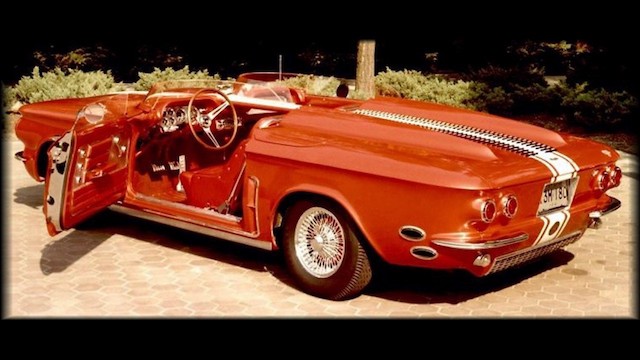 (GM images)
(GM images)
The 1961 Corvair Sebring Spyder.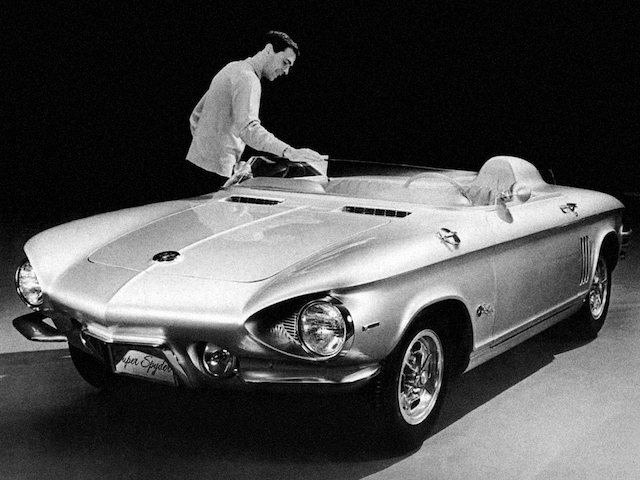 The 1962 Corvair Super Spyder.
The 1962 Corvair Super Spyder.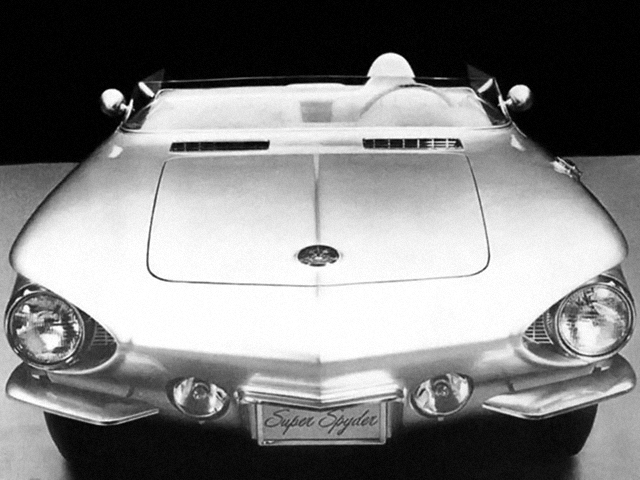 The Super Spyder gleamed in Bill Mitchell's favorite metallic silver.
The Super Spyder gleamed in Bill Mitchell's favorite metallic silver.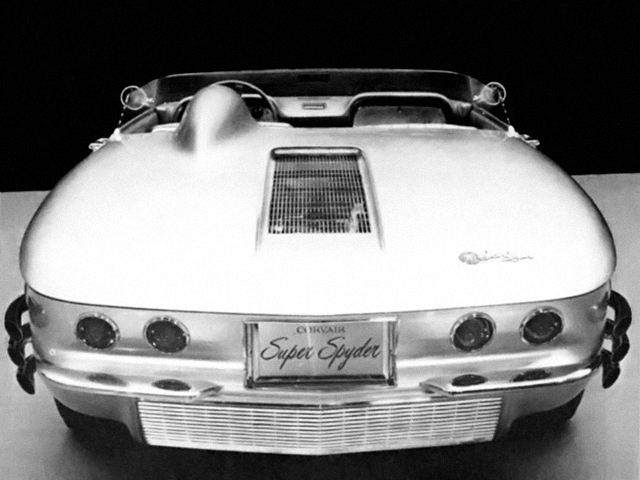 The rear view of the Super Spyder is wild with its triple exhaust pipes and Sting Ray taillights.
The rear view of the Super Spyder is wild with its triple exhaust pipes and Sting Ray taillights.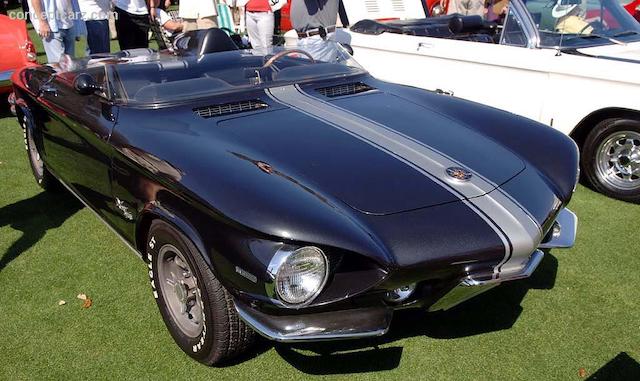 The 1962 Corvair Super Spyder as it appears today.
The 1962 Corvair Super Spyder as it appears today.

(Honda images)
American Honda has confirmed that the unique ADV150 will be brought to the U.S. for the 2021 model year. Already a hit overseas, the model is an unlikely mix of scooter and adventure bike. Featuring a step-through design, substantial tires and robust Showa suspension, the ADV150 is a lightweight, compact scooter with adventure-ready features, a crossover model that embraces both daily commuting and recreation. The ADV150 will be available in June 2020, and priced at $4,299. (4/1) Since its 2018 U.S. return, the Honda Super Cub has won fans with its nostalgic look and friendly performance. For 2021, the highest-selling motor vehicle of all time is back for more, proving that "even 65 years after its debut, you still meet the nicest people on a Honda," according to Honda PR minions. The Honda Super Cub will be priced at $3,749 and also available in June. (4/1)
Since its 2018 U.S. return, the Honda Super Cub has won fans with its nostalgic look and friendly performance. For 2021, the highest-selling motor vehicle of all time is back for more, proving that "even 65 years after its debut, you still meet the nicest people on a Honda," according to Honda PR minions. The Honda Super Cub will be priced at $3,749 and also available in June. (4/1)

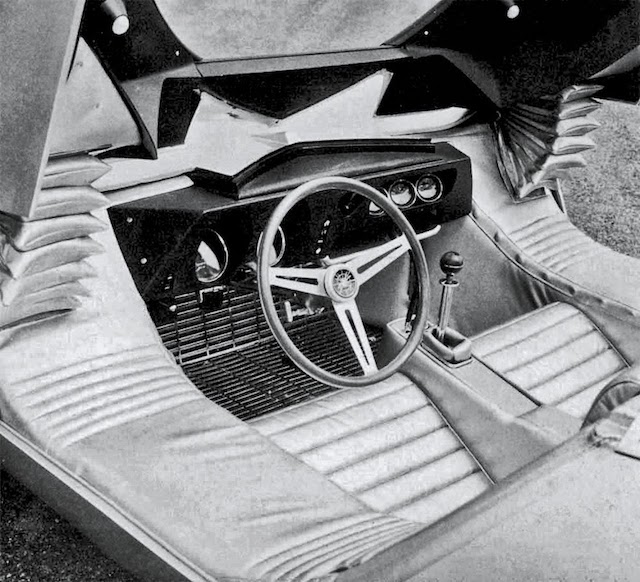 The entire cockpit canopy on the Monza GT raised up and forward.
The entire cockpit canopy on the Monza GT raised up and forward.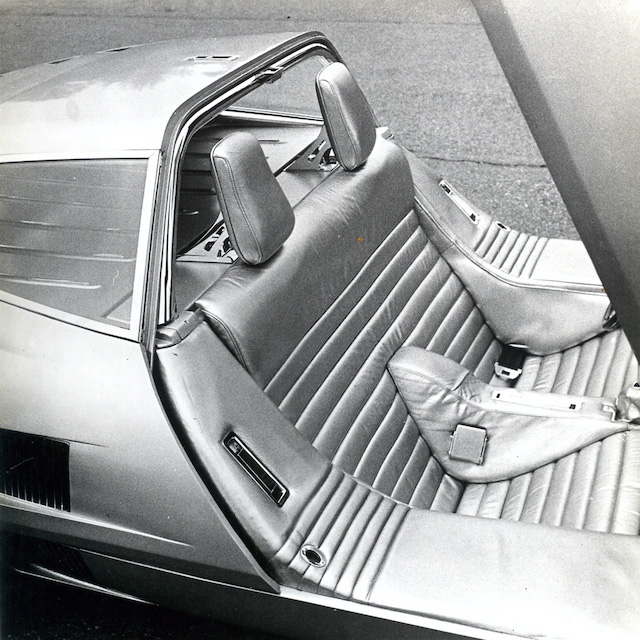 Another look inside at the Monza GT.
Another look inside at the Monza GT.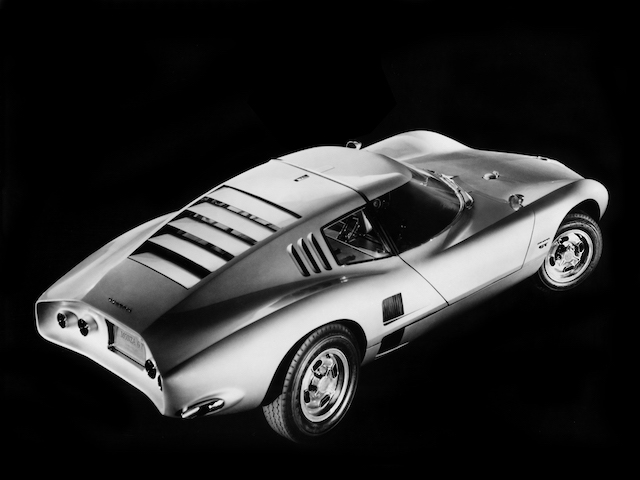 The overhead rear view of the Monza GT influenced many cars, including the Lamborghini Miura.
The overhead rear view of the Monza GT influenced many cars, including the Lamborghini Miura. 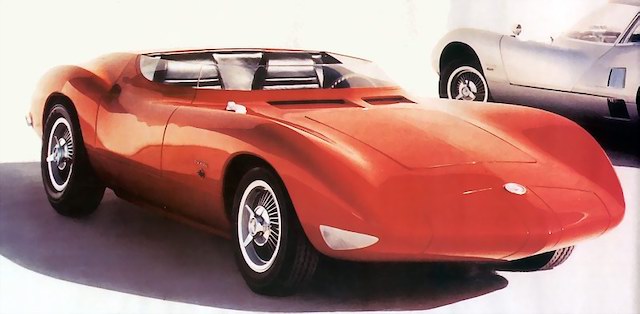 The Monza SS.
The Monza SS.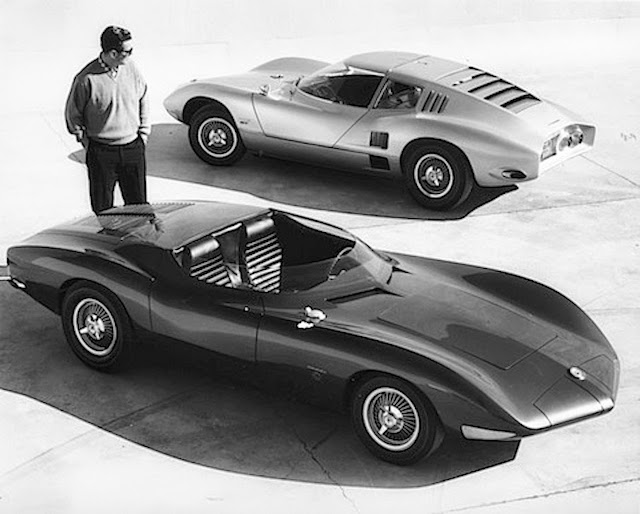 The Corvair Monza SS and GT concepts were two of the most stunning cars to come out of GM Styling during the Bill Mitchell era.
The Corvair Monza SS and GT concepts were two of the most stunning cars to come out of GM Styling during the Bill Mitchell era.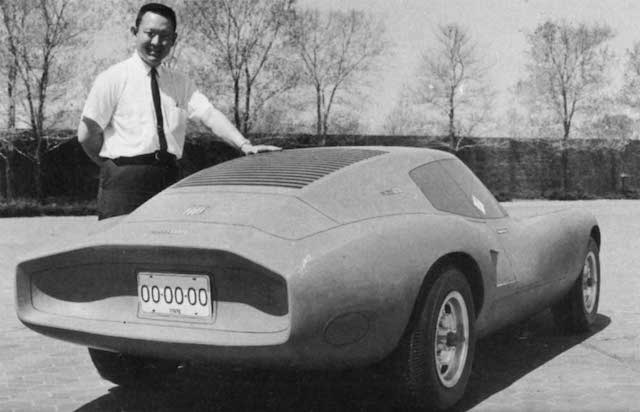 Famed GM designer Larry Shinoda stands by the clay model of the Monza GT concept in the GM Styling viewing courtyard, 1962.
Famed GM designer Larry Shinoda stands by the clay model of the Monza GT concept in the GM Styling viewing courtyard, 1962.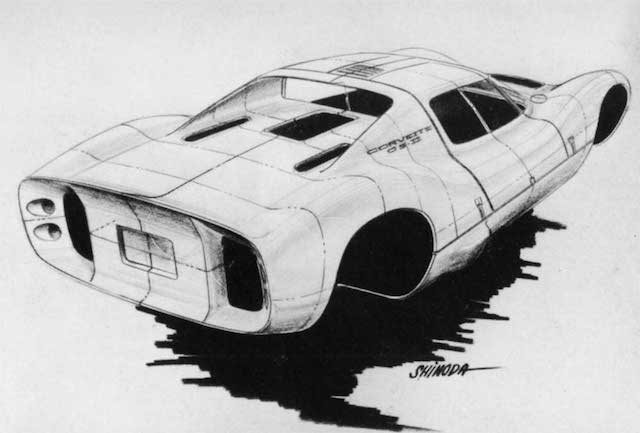 Larry Shinoda's sketch for the Chaparral 2D Coupe with its internal Chevrolet engineering designation - "Corvette GS II" - displayed prominently in 1965. The front end design of the Chaparral 2 was a direct lift from the Monza GT and SS. When the Chaparral 2D first saw the light of day, its resemblance to the Monza GT was unmistakable.
Larry Shinoda's sketch for the Chaparral 2D Coupe with its internal Chevrolet engineering designation - "Corvette GS II" - displayed prominently in 1965. The front end design of the Chaparral 2 was a direct lift from the Monza GT and SS. When the Chaparral 2D first saw the light of day, its resemblance to the Monza GT was unmistakable. Larry Shinoda's more detailed rendering of the Chaparral 2D Coupe, 1966. Jim Hall's relationship with Chevrolet Engineering and GM Styling has been well-documented. It was a mutually beneficial partnership.
Larry Shinoda's more detailed rendering of the Chaparral 2D Coupe, 1966. Jim Hall's relationship with Chevrolet Engineering and GM Styling has been well-documented. It was a mutually beneficial partnership.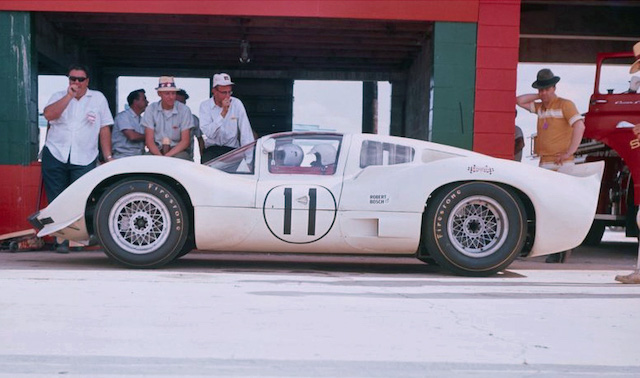

(NBC News)
Editor's Note: From the "You Can't Always Get What You Want File" comes word of a five-year-old boy from Utah, who got mad when his mom refused to buy him a Lamborghini, so he took her SUV and started driving to California to buy one! He was stopped less than five minutes from his home by Utah Highway Patrol. He had $3 in his pocket. -WG (5/6)

(Images provided by Legacy Classic Trucks)
Editor-in-Chief's Note: Custom, retrofitted trucks is the New Thing apparently. This newest product from Legacy Classic Trucks is a $350,000 (!) 1949 four-door Legacy Power Wagon "made for summer excursions," according to the custom-build truck company. Legacy Classic Trucks specializes in full-size resto-modding of vintage Power Wagons. Led by Founder Winslow Bent, Legacy Classic Trucks takes these celebrated American workhorses and restores them from the ground up while modernizing them underneath. This particular truck is outfitted with a Cummins 4BT 8-valve twin-turbo diesel engine capable of producing 350HP and 600 lbs.-ft. of torque. The engine is mated to a five-speed manual transmission to produce a respectable 0 to 60 mph time for a 7,500-lbs. vehicle that can cruise at 80mph all day long. Dana 60 and axles, ARB locking differentials and Warn locking hubs work to ensure the 1949 four-door beast functions on road and off in any terrain. A Warn winch is strategically placed on the vehicle’s front as well, allowing drivers to clear out trails or help tow other vehicles as needed. This powerful Power Wagon rides on 40" Toyo tires on bead-locked wheels with a 144-inch wheelbase. The 1949 Legacy Power Wagon’s interior is also significantly upgraded with bespoke leather seats and grey German square weave carpeted floor mats. A wood steering wheel and vintage-style gauges add a level of period correct styling to an otherwise modernized interior. Other upgrades include a Bluetooth stereo, a modern HVAC system, and USB charging ports. Each Legacy Classic Trucks Power Wagon conversion requires well over 2,000 hours of build time to complete. This new Legacy Classic Trucks 1949 Power Wagon custom is the company’s 108th vehicle. Legacy’s reimagined Power Wagons can be further upgraded based on customer preferences. If you gotta know more, go here:www.legacyclassictrucks.com. -PMD (5/6)



(Alfa Romeo images)
In preparation for Alfa Romeo’s 110th anniversary - to be officially celebrated on June 24, 2020 - the brand is launching a comprehensive heritage package that highlights key moments in its illustrious history. Headlining the heritage package is an interactive e-book, which spans from the brand’s very beginning in 1910, when the first A.L.F.A., the 24HP, was introduced, to today and beyond, with such vehicles as the limited-edition Giulia GTA and the upcoming Tonale crossover.
“Did you know?” facts include:
Did you know the Alfa Romeo logo combines the emblem of the city of Milan and the "Biscione Visconteo," the coat of arms of the Visconti family, which ruled medieval Milan?
Did you know Alfa Romeo won the very first Formula 1 championship in 1950? And the second Formula 1 championship in 1951, with Juan Manuel Fangio securing the title?
Did you know Enzo Ferrari drove for the Alfa Romeo racing team prior to leaving to establish his own car company?
Did you know Hollywood stars from the 1940s aspired to drive Alfa Romeos, especially rare models such as the 6C 2500 Super Sport?
Did you know that the Alfa Romeo 156 D2 race car introduced in 1998 went on to win 13 touring car championships?
All of this and more are detailed in this heritage package, including all of the photography, much of which comes from the archive at the Museo Storico Alfa Romeo in Arese, Italy, and a short video synopsis. Additional content package highlights include:
"My Favorite Alfa Romeo Cars," by Ralph Gilles, Head of Design, FCA.
"Most Significant Performance Cars From Alfa Romeo," by Lorenzo Ardizio, Curator Museo Storico Alfa Romeo.
Evolution of the Biscione logo.
And, the story behind the Trefoil “face.”
(5/20)

The characters in our story are five: this American continent; this American people; the automobile; the Great American Road, and the Great American Roadside. As an American, of course, you know these characters. This continent, an open palm spread frank before the sky against the bulk of the world. This curious people. The automobile you know as well as you know the slouch of the accustomed body at the wheel and the small stench of gas and hot metal. You know the sweat and the steady throes of the motor and the copious and thoughtless silence and the almost lack of hunger and the spreaded swell and swim of the hard highway toward and beneath and behind and gone and the parted roadside swarming past. This great road, too; you know that well. How it is scraggled and twisted along the coast of Maine, high-crowned and weak-shouldered in honor of long winter, how like a blacksnake in the sun it takes the ridges, the green and dim ravines which are the Cumberlands, and lolls loose into the hot Alabama valleys . . . Oh yes, you know this road….All such things you know….God and the conjunction of confused bloods, history and the bullying of this tough continent to heel, did something to the American people -- worked up in their blood a species of restiveness unlike any that any race before has known. Whatever we may think, we move for no better reason than for the plain unvarnished hell of it. And there is no better reason. So God made the American restive. The American in turn and in due time got into the automobile and found it good. The automobile became a hypnosis, the opium of the American people...Whatever we may think, we move for no better reason than for the plain unvarnished hell of it. And there is no better reason. (5/27)

(Porsche images)
Editor-in-Chief's Note: It is no secret that Porsche has the most usurious pricing strategy/option list in the business, and it never hesitates to exploit its fan base to extract every last dollar possible. The operatives at Porsche are the preeminent greed merchants in this business, and that's saying something when there's an industry full of them. The latest evidence? The 2021 Porsche 911 Targa 4S Heritage Design Edition, which will be the first of four special Heritage Design models. Limited to 992 models worldwide, this model is supposed to evoke memories of Porsche models from the 50s. “We are evoking memories of the 1950s, 1960s, 1970s and 1980s in customers and fans with the Heritage Design models. No brand can translate these elements into the modern day as well as Porsche, and, along the way, we’re fulfilling the wishes of our customers. With the exclusive special editions, we are also establishing a new product line which represents the ‘lifestyle’ dimension in our product strategy,” says Oliver Blume, Chairman of the Executive Board of Porsche AG. Let's stop right there, because when Porsche starts talking about "lifestyle" dimensions the brand is in serious trouble. I am not going to bother to regurgitate all of the "exclusive" details, because they're too tedious and contrived to mention, but suffice to say, this brand direction is a new low for Porsche. How much? The 2021 911 Targa 4S Heritage Design Edition has an MSRP of $180,600, not including a $1,350 delivery, processing and handling fee. It is expected to reach U.S. dealers in late 2020. Along with the introduction of the special edition, certain interior elements will be available as part of the Heritage Design package for all current 911 models. But wait, if you really want to be The Biggest Tool in the Shed, Porsche Design has created a high-quality chronograph, also a limited edition, which will be offered for sale exclusively to customers purchasing the special model. The 911 Targa 4S Heritage Design edition chronograph will set you back another $14,000, and it can be purchased at authorized Porsche dealers exclusively by owners (aka The Biggest Tools) of the 911 Targa 4S Heritage Design Edition. Nicely done Porsche, you unmitigated hacks. -PMD (6/3)

(Photo: Deremer Studios, LLC.)
Sunrise at The Amelia: The Corvette Mid-Engine prototypes were brought together to celebrate the arrival of the new 2020 Chevrolet Corvette Stingray at the 25th Annual Amelia Island Concours d'Elegance. To celebrate the launch of Chevrolet's mid-engine Corvette, Bill Warner and his team assembled an inspiring class of nine mid-engine (and one rear-engine) Corvette prototypes. Vehicles in the class included the "alpha" 1960 Chevrolet CERV I (Chevrolet Experimental Research Vehicle), developed by engineer Zora Arkus-Duntov as a platform to develop and refine Chevrolet body, chassis and suspension systems, to the "omega" 1990 Chevrolet CERV III. The latter debuted at the 1990 Detroit Auto Show and paved the way for a future generation of mid-engine concepts while influencing the design architecture of the C5 Corvette. (6/3) (Photo: Deremer Studios, LLC.)
(Photo: Deremer Studios, LLC.)
The 1960 Mid-Engine Chevrolet CERV I. Corvette engineer Zora Arkus-Duntov developed the CERV (Chevrolet Experimental Research Vehicle) as a platform to develop and refine Chevrolet body, chassis and suspension systems. An open-wheeled vehicle with a single seat, the fiberglass body designed by Larry Shinoda in the clandestine "Studio X" weighed only 80 pounds. Zora envisioned the CERV 1 competing in the Indianapolis 500 and even tested it at The Speedway. The Mid-Engine, AWD CERV II is in the background, which Zora wanted to enter in the 24 Hours of Le Mans.

(Photo: Deremer Studios, LLC/Marty V Photography)
The design of the Chevrolet Corvette Astro II (XP-880) was tasked to Larry Shinoda's Chevy 3 Studio and designers George Hubbach, Randy Wittine and Allen Young. Their concept proposal aimed to comfortably carry two passengers and their cargo with the engine and radiator placed in the rear of the vehicle, freeing the front compartment for storage. (Photo by Deremer Studios, LLC.)
(Photo by Deremer Studios, LLC.)
The 1990 CERV III was inspired by the 1986 Corvette Indy. The body - designed by Jerry Palmer's team in Chevy 3 Studio - was a combination of carbon fiber, Kevlar and aluminum honeycomb. The scissor-type doors pivoted up from the fenders. Power came from a twin-turbocharged 5.7 liter V8 producing 650HP. With a drag coefficient of 0.277, the car had a calculated top speed of 225 mph. It featured full-time four-wheel drive and active suspension.

(Honda images)
Celebrating its 60th anniversary this model year, the legendary Monkey oozes history and tradition, having originally been produced in 1961 for Tama Tech, a Honda-owned amusement park in Japan. But while this miniMOTO bike’s looks and spirit are faithful to the Monkey’s earliest concept of making mobility fun, this modern iteration for 2021 touts convenient features that help it perform well and run reliably, which explains why it’s a hit with both nostalgic customers seeking a trip down memory lane, and a new generation of enthusiasts. The Monkey comes in Pearl Nebula Red and Pearl Glittering Blue. How much? $3999.00. Monkey with ABS: $4199.00. (6/10)


(Chevrolet)
Horsepower Alert: Chevrolet Performance announced the all-new LS427/570 crate engine intended exclusively for use in competition vehicles. This is an enhanced version of the production-based LS7 7.0L engine that offers more horsepower, more torque and, thanks to a simpler wet-sump oiling system, easier installation. A new, high-lift camshaft developed specifically for this engine helps produce a GM-estimated 570HP and 540 lb-ft of torque — increases of 65 horsepower and 70 lb-ft over the regular-production engine — while the new wet-sump oiling system eliminates the need for the installer to incorporate a separate oil tank, oil lines and other ancillary components to support the production LS7’s dry-sump system. Compared to the production LS7 crate engine assembly, the LS427/570 features an F-body aluminum oil pan and a specific wet-sump oil pump. Additional engine highlights include:
§ Unique high-lift hydraulic roller camshaft with 0.591-inch intake/0.590-inch exhaust lift; 227-degree intake/242-degree exhaust duration; and a lobe separation angle of 116 degrees
§ Unique high-rate valve springs
§ Camaro fifth-generation Z/28 exhaust manifolds
§ Low-profile LS7 EFI intake manifold with fuel rails, injectors and throttle body installed
§ Robust LS7 rotating assembly featuring a forged steel crankshaft and titanium connecting rods
§ CNC-ported cylinder heads featuring 2.20-inch titanium intake valves and 1.61-inch sodium-filled exhaust valves
§ Fourteen-inch Camaro Z/28 168-tooth manual transmission flywheel
§ Must be used with LS427/570 Engine Controller P/N 19420000 (sold separately)
§ Chevrolet Performance recommends Mobil 1 15W50 fully synthetic motor oil to be used with the engine
The new LS427/570 is available for immediate ordering through Chevrolet Performance dealers and retailers. Go to www.chevrolet.com/performance to locate a dealer. (6/17)

Question: What’s the best an E-Type can be? Eagle - the world’s leading specialist in legendary Jaguars - from East Sussex, England, believes it has the answer. The company's more than 35 years of E-Type experience has been focused on the analysis of every component, identifying no compromise design improvements, followed by an 8,000 hour build to create the missing model in Jaguar’s E-Type evolution: a Lightweight, thoroughly re-engineered to be enjoyed on the road. Only twelve Lightweights were manufactured by Jaguar, introducing their most exotic E-Type for the 1963 season. Noisy, brutal, exhilarating and exhausting, these brilliant race cars were intoxicating on the track and visceral on the road. Six years earlier, Jaguar had re-equipped and re-tuned sixteen of their legendary D-Type racers to create the XKSS: race car fast, yet with a level of comfort and refinement that allowed owners such as Steve McQueen to drive them every day. Until now, there has been no Lightweight E-Type equivalent. “An Eagle E-Type is always an ultimate development of the model, with each variation created for a different type of driver,” explains Eagle founder Henry Pearman. “Three years ago, a customer asked us to create Eagle’s vision of Jaguar’s ultimate E-Type, the Lightweight. The result of that project is the Eagle Lightweight GT, rigorously developed and proven and now ready for further builds.” The challenge for Pearman’s team was even greater than that of creating its three other E-Type Special Editions, the Speedster, Low Drag GT and Spyder GT. “The factory Lightweight was a stripped-out racer. We wanted to retain that special feel of a 60s competition car from an incredible era in British motorsport, but with the comfort, refinement and reliability that would make it an exhilarating daily driver or long-distance GT.” (6/24)
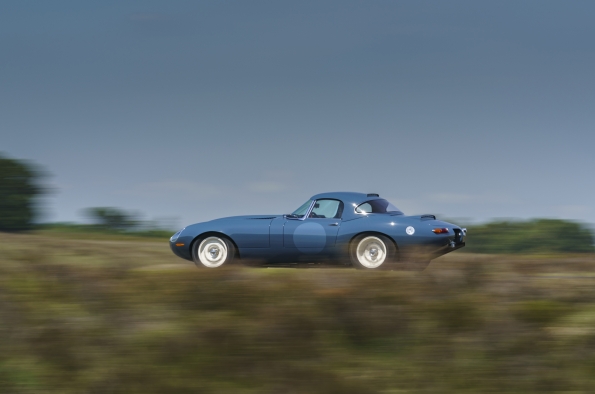 The process begins with a 100 per cent strip-down of an original Series 1 E-Type. Every panel is replaced with lightweight aluminum of a modern grade more suited to road use than the thin, fragile material of the original Lightweights. Specialist craftsmen invest more than 2,500 hours forming the sensual curves, then fitting them to a tolerance many times more demanding than those specified by Jaguar’s Competition Department. The famous Lightweight profile is faithfully recreated, with subtle enhancements to aerodynamics including a deeper rear ramp angle, deeper sills (which also increase chassis stiffness and allow the driver to sit lower, improving headroom and lowering the center of gravity) and increased screen rake front and rear with bespoke glass. Wheel arch size has also been enlarged to accommodate 16” peg-drive magnesium alloy wheels, modeled on the original Dunlop racing wheels but wider, with a little more offset and one inch taller to allow more modern tires.
The process begins with a 100 per cent strip-down of an original Series 1 E-Type. Every panel is replaced with lightweight aluminum of a modern grade more suited to road use than the thin, fragile material of the original Lightweights. Specialist craftsmen invest more than 2,500 hours forming the sensual curves, then fitting them to a tolerance many times more demanding than those specified by Jaguar’s Competition Department. The famous Lightweight profile is faithfully recreated, with subtle enhancements to aerodynamics including a deeper rear ramp angle, deeper sills (which also increase chassis stiffness and allow the driver to sit lower, improving headroom and lowering the center of gravity) and increased screen rake front and rear with bespoke glass. Wheel arch size has also been enlarged to accommodate 16” peg-drive magnesium alloy wheels, modeled on the original Dunlop racing wheels but wider, with a little more offset and one inch taller to allow more modern tires. The heart of the car is Eagle’s 4.7-liter evolution of the famous Jaguar XK straight six that was fitted not just to E-Types, but also to the C and D-Types that, in the 1950s, won an astonishing five outright victories at Le Mans. Factory Lightweights were specified with an aluminum block replacing the iron block of road cars, an upgrade replicated by Eagle. A bespoke crankshaft, pistons and con rods improve responsiveness and durability, while a wide-angle head, as specified for factory Lightweights, accommodates larger valves and a higher lift camshaft for improved breathing. Peak power of 380HP arrives at 5,750 rpm, but the pleasure of this unit is the vast wave of torque: 375 lb ft at 4,000 rpm and a wonderfully flat curve that makes the Eagle Lightweight GT feel effortlessly fast, before an urgent, howling dash for the redline. Ultra-lightweight magnesium alloys are specified for the gearbox case, bell housing, differential case, sump and rear hub carriers. The gearbox has been uprated to a carefully re-engineered, all synchromesh five speed unit, taking care to provide a perfect period feel to the change with no compromise in the position of the lever. There is no compromise allowed in the gearbox ratios either, as each one has been designed to ensure a seamless flow of torque that is ideally matched to the weight of the car and the characteristics of the engine.
The heart of the car is Eagle’s 4.7-liter evolution of the famous Jaguar XK straight six that was fitted not just to E-Types, but also to the C and D-Types that, in the 1950s, won an astonishing five outright victories at Le Mans. Factory Lightweights were specified with an aluminum block replacing the iron block of road cars, an upgrade replicated by Eagle. A bespoke crankshaft, pistons and con rods improve responsiveness and durability, while a wide-angle head, as specified for factory Lightweights, accommodates larger valves and a higher lift camshaft for improved breathing. Peak power of 380HP arrives at 5,750 rpm, but the pleasure of this unit is the vast wave of torque: 375 lb ft at 4,000 rpm and a wonderfully flat curve that makes the Eagle Lightweight GT feel effortlessly fast, before an urgent, howling dash for the redline. Ultra-lightweight magnesium alloys are specified for the gearbox case, bell housing, differential case, sump and rear hub carriers. The gearbox has been uprated to a carefully re-engineered, all synchromesh five speed unit, taking care to provide a perfect period feel to the change with no compromise in the position of the lever. There is no compromise allowed in the gearbox ratios either, as each one has been designed to ensure a seamless flow of torque that is ideally matched to the weight of the car and the characteristics of the engine.  Attention to detail is continued throughout the Eagle Lightweight GT in the most comprehensive review and enhancement of an E-Type ever undertaken, accomplished with great sensitivity to the original feel and aesthetic. Take the driving position as an example. The design of the floor pan, pedal mountings and the rear bulkhead have been tweaked to dramatically increase legroom in the E-Type’s notoriously cramped cabin while the seats are redesigned to improve safety, retention and long-term comfort. The remarkable attention to detail has even increased finger room around the seat adjusters, using the latest 3D printing techniques to create bespoke control levers. Comfortable road use also means resisting the temptation to give the Eagle Lightweight GT an exhaust note that shouts "race car" or a track-focused suspension calibration that too often makes such vehicles too harsh. “Far more challenging is to combine taught, sportscar dynamics with the ride quality and refinement of a world-class Grand Tourer,” explains technical director Paul Brace. Working together with the seats and tires, Eagle’s lightweight suspension, carefully specified geometry, spring rates, bushings and bespoke Ohlins adjustable dampers, ensures long distances can be completed in refreshing comfort.
Attention to detail is continued throughout the Eagle Lightweight GT in the most comprehensive review and enhancement of an E-Type ever undertaken, accomplished with great sensitivity to the original feel and aesthetic. Take the driving position as an example. The design of the floor pan, pedal mountings and the rear bulkhead have been tweaked to dramatically increase legroom in the E-Type’s notoriously cramped cabin while the seats are redesigned to improve safety, retention and long-term comfort. The remarkable attention to detail has even increased finger room around the seat adjusters, using the latest 3D printing techniques to create bespoke control levers. Comfortable road use also means resisting the temptation to give the Eagle Lightweight GT an exhaust note that shouts "race car" or a track-focused suspension calibration that too often makes such vehicles too harsh. “Far more challenging is to combine taught, sportscar dynamics with the ride quality and refinement of a world-class Grand Tourer,” explains technical director Paul Brace. Working together with the seats and tires, Eagle’s lightweight suspension, carefully specified geometry, spring rates, bushings and bespoke Ohlins adjustable dampers, ensures long distances can be completed in refreshing comfort. Most of the revisions, like the gorgeous peg-drive magnesium alloy wheels and aluminum three-eared wheel spinner nuts, could be described as ultimate developments of the correct period technologies, but there are also carefully selected modern systems that have been discreetly integrated. Braking is by four piston, servo assisted vented discs, a subtly integrated electrical distribution panel increases safety and reliability and the extreme cabin heat of the original is solved by modern thermal barrier materials and the careful integration of a discreet air conditioning system designed in-house to eliminate the compromises that would be inevitable with a bought-in design.
Most of the revisions, like the gorgeous peg-drive magnesium alloy wheels and aluminum three-eared wheel spinner nuts, could be described as ultimate developments of the correct period technologies, but there are also carefully selected modern systems that have been discreetly integrated. Braking is by four piston, servo assisted vented discs, a subtly integrated electrical distribution panel increases safety and reliability and the extreme cabin heat of the original is solved by modern thermal barrier materials and the careful integration of a discreet air conditioning system designed in-house to eliminate the compromises that would be inevitable with a bought-in design. Pearman says the Lightweight GT is a classic supercar that fuses the character and charm of the original Jaguar E-Type with the intoxicating thrills of a 1963 factory Lightweight, thoughtfully and comprehensively re-engineered to ensure the new owner enjoys every mile, every day. For enthusiasts wanting to wrap the intense flavors of 60s motorsport in the sumptuous, hand crafted comforts of a luxury GT, “this,” he states with confidence, “is as good as an E-Type can be.” The Lightweight GT joins Eagle’s three established E-Type special editions: the Speedster, Low Drag GT and Spyder GT. Just two of these E-Types will slip discreetly from their UK workshops each year, each one the product of more than 8,000 hours of skilled workmanship and 35 years of focused, passionate, E-Type experience. More? Go here: www.eaglegb.com
Pearman says the Lightweight GT is a classic supercar that fuses the character and charm of the original Jaguar E-Type with the intoxicating thrills of a 1963 factory Lightweight, thoughtfully and comprehensively re-engineered to ensure the new owner enjoys every mile, every day. For enthusiasts wanting to wrap the intense flavors of 60s motorsport in the sumptuous, hand crafted comforts of a luxury GT, “this,” he states with confidence, “is as good as an E-Type can be.” The Lightweight GT joins Eagle’s three established E-Type special editions: the Speedster, Low Drag GT and Spyder GT. Just two of these E-Types will slip discreetly from their UK workshops each year, each one the product of more than 8,000 hours of skilled workmanship and 35 years of focused, passionate, E-Type experience. More? Go here: www.eaglegb.com
Editor-in-Chief's Note: The Detroit Free Press devoted three pages (including the front page) to the unveiling of the 2021 Ford-F150 in Friday morning's paper. They don't call Detroit a company town for nothin', folks. -PMD (7/1)

(Dodge)
Dodge called its new, 797HP Charger SRT Hellcat Redeye "the Most Powerful and Fastest Mass-produced Sedan in the World," and who are we to argue? To back its claim Dodge offered these statistics: It has the most powerful production V8 engine with 797HP and 707 lb.-ft. of torque; it has a top speed of 203 mph; and it is the quickest production Charger ever with a quarter-mile elapsed time (ET) of 10.6 seconds at 129 mph. The Charger SRT Hellcat Redeye features the aggressive Widebody, introduced on the Charger SRT Hellcat in 2020 as standard, with integrated fender flares that add 3.5 inches of width over the wider wheels and tires. Redeye models also feature a newly designed, functional performance hood. Dealer orders for the 2021 Dodge Charger models opened this fall, including the new SRT Hellcat Redeye; vehicles are scheduled to start arriving in dealerships in early 2021. (7/1)

(Porsche)
Porsche introduced its 2021 911 Turbo Coupe and Cabriolet to its brand faithful. This follows the recent introduction of the hotter 2021 911 Turbo S. But then again, the new "standard" Turbo models are plenty quick in the performance department, thanks to an output of 572HP (427 kW), which is an increase of 32HP over its predecessor. How quick? The new 911 Turbo accelerates from 0 to 60 mph in 2.7 seconds (0.2 seconds faster than before) while the new 911 Turbo Cabriolet takes 2.8 seconds (also 0.2 seconds faster). The acceleration, power output and torque (553 lb.-ft.) of the new all-wheel-drive 911 Turbo are on the level of the previous 2019 911 Turbo S. Like the 2021 911 Turbo S, the twin-turbo boxer engine in the 911 Turbo models is mated to a standard eight-speed PDK transmission with Turbo-specific internals and calibration. The top track speed of the new 911 Turbo models is 198 mph. New options such as a Sport and Lightweight package, Sport Suspension with a lower ride height and Sport Exhaust system - first introduced for the 911 Turbo S - are also available for the 911 Turbo for the first time, providing an even higher degree of customization than ever before (and maximum cash extraction from the Porsche faithful). The 2021 911 Turbo models are available to order now and are expected to reach U.S. dealers early next year. How much? Just go ahead and bring a duffel bag stuffed with $100 bills. $170,800 for the 911 Turbo Coupe and $183,600 for the 911 Turbo Cabriolet, both not including the $1,350 delivery, processing and handling fee. (7/22)
Editor-in-Chief's Note: There seems to be a bit of a buzz out in Internet Land around the fact that Jim Farley is an "enthusiast" and so that means Ford is in good hands. Let me assure the uninformed out there that whether or not Farley is an enthusiast matters not one iota when it comes to Ford's future. Instead, look to Ford's product development chief - Hau Thai-Tang - and the other True Believers in Ford Design, Engineering and Product Development, because they will determine Ford's fate. But don't worry, if things go south Farley will deflect the blame, and if things go swimmingly well, he will take all of the credit. -PMD (8/5)

(Volvo)
This is the new "minimalist" Volvo. The only options are a windshield, seat belts and airbags, and surround vision cameras. All for $5,999.00 - if you act now! Actually, it's Volvo's Compact Modular Architecture (CMA) platform, which was co-developed by Volvo Cars and Zhejiang Geely Holding (Geely) and introduced in 2017. The Volvo Car Group, including its strategic affiliates Lynk & Co and Polestar, have sold - including to the end of July - more than 600,000 group vehicles based on the platform. (8/5)





(Ram Trucks)
Get all the details on the new 2021 Ram 1500 TRX here. Also, not leaving any opportunity to extract money from its faithful untouched, Ram Truck is offering a special Ram 1500 TRX Launch Edition (below). Limited to 702 units - in tribute to its 702HP - the TRX Launch Edition is visually distinguished by its exclusive Anvil Gray paint and red and brushed-aluminum center console badge identifying it as a special, limited-edition TRX model. The Ram 1500 TRX Launch Edition package is coupled with the TRX Level 2 Equipment Group, which adds carbon fiber interior trim, color accent package, Head-up Display, beadlock-capable wheels, 19-speaker Harman Kardon premium sound system, dual-pane panoramic sunroof and bodyside graphics. Production of the 2021 Ram 1500 TRX Launch Edition starts in early fourth-quarter 2020 at FCA’s Sterling Heights (Michigan) Assembly Plant. UPDATE: Ram Truck announced that orders for the 2021 Ram 1500 TRX Launch Edition were filled in approximately three hours on Tuesday, August 18. Only 702 - commemorating the TRX's 702HP 6.2-liter supercharged HEMI V8 - of the Launch Edition trucks were offered to U.S. buyers. (8/19)
The Sheer Joy of Driving.
By Tom Pease
Beverly Hills. One of the things I lament about the fact that we seem to be careening toward a future of shiny happy people movers is stories of the sheer joy of driving like yours, or mine. Although mine aren't anywhere near as interesting, I will share one: When I was a kid in Massachusetts, I had no intention of getting my driver's license. I liked cars, but at a young age decided that I was going to go and live in New York. Manhattan, thank you. (I just adore a penthouse view...) So, I figure, why do I need to drive? Everybody in New York takes cabs, right? My brother was silently incensed by this; no brother of his was going to eschew driving under his watch! So on my 16th birthday I came home to find sitting in the driveway a banana yellow 1967 Barracuda Convertible with a black bumblebee stripe and a 318 under the hood - he thought I'd rack up a 383 in about ten minutes. He looked at me and said, “So, you going to get that driver’s license?” I did. Yes, I moved to New York (and quickly moved out) and since then have had a string of convertibles, from a FIAT 124 Spyder which was a joy when running and punishment when not, a Chrysler LeBaron with a pokey four-pot to the BMW Z3 I have today. In fact I credit the Z3 with keeping me somewhat sane during the Covid crisis: I may not be able to go to the movies or hang out with friends but I can put the top down and whiz through the “esses” on Mulholland, zip down Topanga Canyon, or just take the ride by the sea on PCH, smell the ocean air and listen to Anthony Valadez spin some tunes on KCRW. Somehow, I can't see trying to hang out the rear end on the 150 degree turn from Coldwater onto Mulholland in a Prius. Even if it could I don't think the effect would be quite the same. (8/19)

From the "Huh?" File: No, it's not April 1st. Hyundai has unveiled a new project coming from its European design center, Hyundai Design Center Europe. The teaser image reveals the shape of a yellow soapbox derby-type car, with the Hyundai logo visible on the side. The "soapbox" refers to the motorless, gravity-propelled vehicles that were a staple in this country for decades. Originally made from discarded wooden soap crates, today they apparently boast more modern and sophisticated designs. They are particularly popular in Europe and North America, where many soapbox derbies take place. More details, including Hyundai’s plans to make a design inspired by the traditional soapbox accessible for customers around Europe, will be revealed soon. Alrighty then! (8/26)

(Cyan Racing)
Cyan Racing, the reigning triple World Touring Car Champions, has revealed the Volvo P1800 Cyan, an interpretation of the iconic Volvo sports car from the sixties. The car is engineered by the team behind the first world title-winning Volvo race car and the Volvo C30 Polestar Concept Prototype. Its standout features? High-strength steel and carbon fiber body; Bespoke and independent fully adjustable chassis; 420HP and a weight of 990kg. ”Our company was founded in 1996 to race Volvo cars in Sweden and the Volvo P1800 Cyan is closing the circle for us,” said Christian Dahl, CEO and founder of Cyan Racing. "We claimed our first world title with Volvo in 2017 and have since then won two further world titles with two other manufacturers. The first world title was a milestone for us, and we felt it was a good time to reconnect with the past and to those before us racing Volvos. The first Volvo P1800 Cyan carries our blue and yellow racing colors to mark our heritage.” The original Volvo P1800 was unveiled in 1960, a year before the Jaguar E-Type, two years before the Ferrari 250 GTO and three years before the Porsche 911. "The Jaguar, the Ferrari and the Porsche are all cars with a continuation,” said Dahl. “That left us with inspiration to create what could have been if we as a race team had been there during the sixties, racing the P1800, and got to design a road version of our race car. The Volvo P1800 Cyan is our interpretation of what could have been.” In the age of autonomous driving, electrification and connectivity, Cyan Racing decided it was time to capture what has been and to make it timeless."Obviously we could have built an electric Volvo P1800 filled with all the latest technology, comfort and luxury. But that was not what we wanted," Dahl continued. "Amid this paradigm shift we decided to slow down time and freeze a part of it in our own time capsule. To take the best from the golden sixties and combine it with our capabilities of today, keeping a pure yet refined driving experience." While creating the Volvo P1800 Cyan, the team behind it decided to treat the design and engineering of the sixties with care, moving it forward in a delicate way. "We decided to apply our expertise in engine, aero and chassis design for a car that delivers on the Cyan engineering philosophy in terms of predictability and intuitive driver control, yet keeping the light-weight, analogue driving experience of the sixties," said Mattias Evensson, Project Manager and Head of Engineering at Cyan Racing. There are no driver aids to distort the driving experience, meaning no stability control, ABS or brake booster. The P1800 Cyan is powered by a 2.0-liter turbocharged four-cylinder engine based on the same engine as used in the world title-winning Volvo S60 TC1 race car, producing 420HP and 455Nm of torque, with a redline at 7700 rpm. "The Volvo P1800 Cyan is about clearing away anything disturbing the direct connection between driver, tires and the road. Our objective has been to keep that undisturbed sensation whilst refining it with the best technology of today," said Mattias Evensson. The company will build more of these P1800 hot rods, but no prices have been discussed. Needless to say, plan on bringing piles of ca$h-ola. (9/2)




(Honda)
You can go home again, apparently. Sixty years after Honda introduced customers to the joys of casual on- and off-road riding, the all-new 2021 Honda Trail 125 ABS (CT125) resurrects a revered brand by injecting a healthy dose of practical design and hassle-free technology to create a miniMOTO that — much like the Super Cub and Monkey — "pays tribute to the past while adapting easily to modern lifestyles." The new 2021 Honda Trail 125 expands upon the scope of the popular Super Cub C125 to include casual riding in rural settings, including two-track roads and trails. Honda strengthened the C125 chassis, increased suspension travel and improved fuel range. The engine is the same 125cc four-stroke, single-cylinder overhead-camshaft design operating two valves, but with a high-mounted air intake and up-swept exhaust to enhance low-end and mid-range power. As with the Super Cub, the Trail 125 has a four-speed semiautomatic transmission. The engine guard adds protection from obstacles like large rocks and tree stumps. “When American Honda was established in 1959 and began offering the Honda 50, Idaho dealer Herb Uhl started modifying it for off-road use, resulting in Honda producing the Trail 50,” said Lee Edmunds, Senior Manager of Powersports Marketing for American Honda. “That model became ubiquitous in American campgrounds and on motorhome bumpers in the ’60s and ’70s and led to a number of successors. For that reason, the CT brand has a special history with the U.S. market, and it’s great to see it return with the Trail 125 which, like the Super Cub and Monkey, harkens back to a golden era of American motorcycling but with modern technology and reliability.” The 2021 Honda Trail 125 is scheduled for release in November and will be available in Glowing Red. The MSRP is $3,899. (9/9)

(Land Rover images)
The 2021 Land Rover Defender X-Dynamic bridges the gap between Defender and Defender X with a tougher exterior look and unique interior fittings to set it apart from the rest of the lineup. The Defender X-Dynamic can be enhanced further with a choice of S, SE and HSE Specification Packs. Other details? A maximum payload of up to 1984lbs, static roof load of up to 661lbs, dynamic roof load of 370lbs, towing capacity of 8,201lbs and wading depth of up to 35.43 inches. Land Rover Terrain Response® technology offers a new Wade program and off-road Configurable Terrain Response® allowing experts and novices to optimize traction in various conditions. The 2021 Land Rover Defender is available to order now, priced from $46,100 in the U.S. You can configure one at www.landroverusa.com (9/9)

(Jeep)
The Jeep® brand and Ann Druyan, the widow and collaborator of Carl Sagan, have joined together to create the 90-second video "Pale Blue Dot," which launches the new Jeep Wrangler 4xe and puts attention on efforts to combat climate change. With every completed view of “Pale Blue Dot” on Jeep brand’s YouTube page, the brand will make a contribution to Coalition for Rainforest Nations and the Carl Sagan Institute of Cornell University to combat climate change. On Feb. 14, 1990, famed scientist Carl Sagan gave the world an astonishing vantage point of the planet we call home. In 1981, Sagan, a member of the mission’s imaging team, began lobbying NASA to turn Voyager 1’s camera for one last look homeward, once it had completed the first reconnaissance of the outer planets. The resulting image with the Earth appearing as a tiny speck, miniscule in size from out beyond Neptune, almost 4 billion miles away, became known as "the pale blue dot." The brand worked together with Emmy and Peabody Award-winning American writer, producer, director Ann Druyan (Founder and CEO of Cosmos Studios, maker of science-based entertainment) on creative elements of the piece, hinging on Carl Sagan’s narration. The Jeep brand’s “Pale Blue Dot” video includes passages from Sagan’s 1994 book "Pale Blue Dot: A Vision of the Human Future in Space” in which he spoke in-depth about the photograph. Editor-in-Chief's Note: This video is well worth your time, it is beautifully executed. -PMD (9/16)

(Nissan)
Nissan has unveiled the Z Proto, signalling the company's intent to launch a new generation of its Z sports car. Shown at an event beamed around the world from the Nissan Pavilion in Yokohama, Japan, the prototype features new design inside and out, as well as an upgraded powertrain with a manual transmission. This is what Nissan PR minions say: "the Nissan Z Proto pays full respect to 50 years of Z heritage. At the same time, it's a thoroughly modern sports car." Editor-In-Chief's Note: This is what I say: Really? That's all you got, Nissan Design? How many times can you go to the same well? Why not re-manufacture the original Z with a modern drivetrain, technology and safety systems? Or is that what the Z Proto is supposed to be? I hope "Z" aficionados are happy, but I'm feeling none of it. I've seen this before, oh, about 100 times. It's derivative, predictable and boring. I am not impressed. -PMD (9/16)

In the autumn of 1950 a fateful meeting between Professor Ferdinand Porsche and Max Hoffman led to the decision that a fledgling German automotive manufacturer from humble beginnings would begin exporting its sports cars to America. This year, Porsche is celebrating the 70th anniversary of its arrival into the American market. The first Porsche sports car received its certification for road use in Germany on June 8, 1948, meaning the history between the brand and the U.S. goes back almost to the very beginning. The young sports car company caught the eye of a visionary New York-based salesman, Austrian expatriate Max Hoffman, who had arrived in New York on June 21, 1941. In 1947, Hoffman opened his showroom on Park Avenue, which was later redesigned by Frank Lloyd Wright. "Hoffman Motor Car Company" began importing and selling established European brands to such a degree of success that it allowed taking a chance with less-known marques. The initial relation between Max Hoffman and Professor Ferdinand Porsche went back to when Hoffman was still working as a lawyer in Vienna, but the decisive contact was made years later by Max Troesch. A journalist by trade, Troesch had driven a Porsche 356 and proclaimed: "I am sure this car will make a name for itself." When he traveled to America, he showed Hoffman photos of the car and encouraged him to connect with Porsche. The first two 1.1-liter 356 coupes were delivered to Hoffman in the fall of 1950, and he met Ferdinand Porsche at the Paris Motor Show that same year. In early conversations, Ferry Porsche said he would be happy to sell five cars a year in America, to which Hoffman famously replied: "If I can't sell five a week, I'm not interested." Eventually, they agreed on a U.S. import contract of 15 cars per year. The first Porsche was considerably more expensive and had a smaller engine than other sports cars at the time, but Hoffman knew that anyone who drove a car from Zuffenhausen would understand it offered a blend of durability, track-bred agility and everyday usability that was unique to the automotive landscape. Porsche had no budget for a major advertising campaign, so it was up to Hoffman to establish this unknown brand to American customers. His marketing materials described the 356 as "One of the World's Most Exciting Cars" with "A new conception in handling, roadholding, suspension and safety never known before." The strategy gained traction, and by 1954, 11 cars per week were sold through Hoffman, equaling 30 percent of the annual Porsche production. In 1965, the final year of the 356 model, the U.S. share of Porsche sales had risen to a massive 74.6 percent. A substantial part of the growing success was thanks to another Austrian native. John von Neumann had opened "Competition Motors" in North Hollywood in 1948, and after a single test drive while visiting Hoffman in New York in 1951, he bought a Porsche 356 and brought it back to California. An avid racer himself, Neumann played an important role in introducing the Porsche brand to the growing motorsports scene in the Golden State. In particular, the nimble new Speedster model would prove popular with its lower price starting at just $2,995. The Speedster was inspired by the 356 America Roadster, which was in turn an example of Hoffman's influence on the company since he had specifically asked Ferry Porsche for a lightweight, entry-level car. Neumann was also well-connected in Hollywood, and his list of celebrity customers, which included actor James Dean, helped build a strong image as the cars were used for weekend racing and weekday commuting alike. With Porsche becoming more established in showrooms, motorsports and pop culture, the decades that followed would see a variety of changes for the brand's presence in the U.S. From an organizational perspective, this began with the creation of the independent distribution network, The Porsche of America Corporation in 1955. From 1969 the company formed part of the Porsche Audi division of Volkswagen of America, Inc., and on September 1, 1984, Porsche Cars North America was established in Reno, NV. And finally, on May 12, 2011, PCNA announced that it would build its new headquarters in Atlanta. By 2019, Porsche sold a record 61,568 vehicles in the U.S. After the global premiere of the fully electric Taycan in September 2019, the very first deliveries in the world were to American customers in December of the same year. Seventy years after Max Hoffman introduced the sports cars from Zuffenhausen to the U.S., the next chapter for Porsche is still being written. (9/30)
 (Corporate Archives Porsche AG)
(Corporate Archives Porsche AG)Max Hoffman was instrumental in bringing Porsche to the U.S. His dealership, Hoffman Motor Car Company, opened on Park Avenue in New York City in 1947 (pictured here around 1954/1955).
Form follows...
By Tom Pease
Beverly Hills. Back in the day, architects decided to throw off the conventions of design, eschewing decorative touches such as corbels, moldings, and bric-a-brac for clean lines that expressed the structure underneath, creating a “machine for living." The edict was “form follows function.”
In Hollywood, designers such as Adrian at MGM coped with the figure flaws of their stars. When confronted with Joan Crawford's linebacker shoulders, he decided to pad them, creating a fad that swept the world and keeps popping up every few decades to this day. That was “form follows fabulous.”
In the automotive world we now have cookie-cutter sameness in the styling as pointed out in this week's Rant. We also have an over-run of Frankly Fake design add-ons that are the auto design equivalent of faux stone or hoop skirts. Things like giant plastic grilles that in no way conceal the fact that the actual opening is a small slot, or a frankly fake “window” trying to conceal an overly chunky “C” pillar.
What would this be? “Form follows fatuous”? "Form follows frivolous”? Maybe "Form follows f-ed up"? (9/30)

(Adobe)
Editor-In-Chief's Note: Pure visual artistry on display. Watch this commercial for the Adobe Creative Cloud called "Commute" featuring "She's Like A Rainbow" by The Rolling Stones. The advertising agency is 72andSunny. Stunning work. -PMD (10/7)

General Motors announced that its Detroit-Hamtramck Assembly Center will be known as Factory ZERO from now on, reconfigured to an all-electric vehicle assembly plant. The name Factory ZERO reflects the significance of this facility in advancing GM’s zero-crashes, zero-emissions and zero-congestion future. Factory ZERO will not only be the launchpad for GM’s multi-brand EV strategy; the facility has advanced technology and tooling and was designed with a focus on sustainable manufacturing. Both the upcoming GMC HUMMER EV pickup and the Cruise Origin - a purpose-built electric, self-driving, shared vehicle - and other GM EVs will be built at Factory ZERO. The HUMMER EV and the Cruise Origin will be built on GM’s Ultium battery platform. Ultium is flexible enough to build a wide range of EVs — cars, trucks and more — and is the heart of GM’s future EV lineup. GM is investing $2.2 billion in Factory ZERO for retooling and upgrades that will position the facility to build EVs at scale. It represents the single largest investment in a plant in GM history. Once fully operational, the plant will create more than 2,200 U.S. manufacturing jobs. Production of the GMC HUMMER EV pickup will begin in late 2021. (10/14)

(GMC images)
GMC unveiled the 2022 HUMMER EV Edition 1 Tuesday night, calling it "a first-of-its kind supertruck developed to forge new paths with zero emissions." It will be the first fully electric addition to GMC’s lineup, driven by next-generation EV propulsion technology "that enables unprecedented off-road capability, extraordinary on-road performance and an immersive driving experience designed to put occupants at the center of every moment," according to GMC PR minions. “This innovative truck comes to market with speed and purpose, bringing GM another step closer to an all-electric future,” said Mark Reuss, president of General Motors. “With our Ultium Drive architecture as the foundation for an exceptionally broad range of performance, HUMMER EV is perfect for the customer who wants capability, efficiency and performance.” The HUMMER EV will get its energy from General Motors’ all-new Ultium batteries and power from Ultium Drive, GM’s proprietary EV drive units. A GM-estimated best-in-class 1,000HP and GM-estimated 11,500 lb-ft of torque are generated by three separate motors within two Ultium drive units to give HUMMER EV’s e4WD remarkable on- and off-road capabilities. Additional purposeful and intuitive technologies will complement the truck’s range and capabilities to enhance and elevate every excursion. “We had one goal for HUMMER EV: Build the most capable factory truck - ever,” said Al Oppenheiser, GMC HUMMER EV chief engineer. “It’s an absolute off-road beast with a unique e4WD drive system that provides maneuverability unlike anything GM has ever offered before.” (10/21)



(Darin Schnabel © 2020 RM Sotheby's)
RM Sotheby's, in association with the Sotheby's Fine Art Division, has announced that it will offer the Alfa Romeo Berlina Aerodinamica Technica Concepts - a trio of incredible automotive and sculptural design achievements that were produced by Bertone for the Turin auto salons in 1953, 1954 and 1955, at Sotheby's upcoming Contemporary Art Evening Sale in New York, on October 28, 2020. Regarded by many as the seminal vehicle designs of the 20th century - B.A.T. 5, 7 and 9 - this trio of spectacular Alfa Romeo concepts will be offered as a single lot. The three cars were more than just design studies and a showcase of what the world's best artisans and craftsmen could create; they also made a lasting impact in design, engineering and aerodynamics, with a hitherto unseen blend of sculpture and efficiency, with more than a hint of fantasy and science fiction thrown in for good measure. Interestingly, the three B.A.T.s were never shown together in period, and the cars were sold off following their respective show circuit runs. In fact, the cars were not united until the 1989 Pebble Beach Concours d’Elegance, sharing the spotlight with none other than Nuccio Bertone, the man who oversaw their commission and construction. Shortly after this, the current owner individually acquired each car, and the trio has been restored, maintained and kept as a group ever since. They have only ever made very occasional public appearances over the past 30 years, and the cars are undoubtedly one of the most important single collections of vehicles in existence. It is therefore fitting that the cars are being sold as a single lot and befitting their unquestionable status as design icons and possibly the best example of ‘cars as works of art,’ the cars will be offered by Sotheby’s with a pre-sale estimate of $14,000,000 to $20,000,000. (They sold for $14.84 million -WG) (10/28)

(Chevrolet)
Chevrolet will showcase a 1977 K5 Blazer converted to all-electric propulsion at SEMA360. The K5 Blazer-E is a functional proof of concept of the upcoming Electric Connect and Cruise package Chevrolet Performance plans to sell in the second half of 2021. The new K5 Blazer-E retains as much of the stock Blazer as possible and approximately 90 percent of the new parts installed for the eCrate package are factory components from the Chevrolet Bolt EV. To convert the 1977 K5 Blazer, the team first removed from the Blazer the original 175-horsepower 400 cubic-inch V-8, three-speed automatic, fuel system and exhaust. Then, the team installed a Bolt EV electric motor, delivering 200 horsepower and 266 lb-ft of torque, paired with a Chevrolet Performance electronically controlled four-speed automatic. The rest of the Blazer drivetrain remains untouched, including the transfer case, driveshaft and axles. Power is supplied by a 400-volt Bolt EV battery pack with 60 kilowatt-hours of usable energy installed in the cargo area. Using production controllers and wiring harnesses preserves many Bolt EV features, including shock protection, battery heating and cooling, battery-overcharge protection and even regenerative braking. The aftermarket components include an electric power steering kit, an electric pump providing vacuum to the stock brake system, and an electronic controller to drive inputs to the vintage Blazer gauges – such as displaying the battery’s state of charge on the original fuel gauge. To prepare for the eCrate launch, Chevrolet Performance is certifying Electric Connect and Cruise installers. Participating Chevrolet dealers and aftermarket companies will receive the training, tools and equipment needed to work with high-voltage systems and charging stations to service customers’ vehicles. Lingenfelter Performance Engineering in Brighton, Michigan will be the first company to pilot the training and certification program. This experience will help inform the certification process for future installers. (10/28)

(Aznom)
This is the Aznom Palladium. This is what the PR minions at Aznom have to say: "Palladium is without any doubt a unique and surprising automobile and, as in the intention of the manufacturer, is ready to fill a rather interesting and exclusive niche." The designers have dubbed it a “hyper-limousine” as it "unites the traditional characteristics of great luxury sedans (such as comfort, quality of materials and manufacturing, ample space and reliability) with outstanding capabilities usually peculiar to other types of cars." “We have produced this vehicle choosing artisanal manufacturing techniques that are almost lost today, such as panel beating and hand-crafting the body of the car, together with other technological solutions," said Aznom’s founder Marcello Meregalli. "Engine builders, tanners, panel beaters, designers and engineers who have worked on this project are heirs to a tradition that has made Italian cars famous all around the world.” The name of the vehicle itself "points to majestic and classic esthetics, taking inspiration from the mansions of renowned Italian architect Andrea Palladio," (famous for using ancient Greek and Roman styles as the base for his creations). Just shy of 2 meters in height and almost 6 meters in length, the Aznom Palladium is equipped with a 5.7 liter biturbo engine capable of delivering more than 700HP and 950 Nm of torque. Editor-In-Chief's Note: Sometimes words won't suffice, but initials will, as in WTF? They plan on building just ten of these mobile atrocities. Oh, and one more thing. Why? -PMD (11/4)
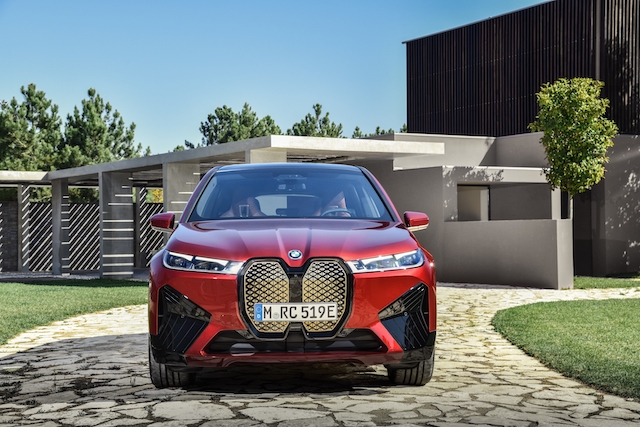
(BMW)
This is what BMW says: "A vision is turning into reality, as the BMW Vision iNEXT becomes the BMW iX. With time still to go before its expected U.S. market launch in the early 2022 and with the series development phase ongoing, BMW is providing a first look ahead at the future BMW iX. The BMW iX is the first model based on a new, modular, scalable architecture on which the future of the BMW Group will be built. Conceived from the outset as purely electric mobility, the iX sees BMW redefining the successful Sports Activity Vehicle (SAV) concept. The BMW iX has been created to provide something beyond just mobility – an exhilarating driving experience combined with a sense of well-being for both drivers and passengers all the while enjoying the journey with safety, security, and a new form of luxury in the process." Editor-In-Chief's Note: I have been in and around this business for a very long time. And I can deduce when a product is so far off of the mark that it will be sales-proof the moment it hits dealer showrooms. This is one of those times. This rolling monument to tedium is an example of design hubris the likes of which we haven't seen since the Edsel. This mobile atrocity sends the convincing message that BMW is fully intent on becoming an also-ran car company going forward. Irrelevant and offensive are not exactly the words marketing campaigns are based on. What a frickin' joke. -PMD (11/11)

(Porsche Design)
Editor-In-Chief's Note: It's no secret that Design is my favorite part of this business. I have been privy to many previews of future designs over the years, but never for Porsche. Calling it their "Unseen" series, Porsche has decided to reveal some of its most compelling concepts from its design center's secret archives, including these six hypercars never before seen by the public. The first image (above) is of the Porsche 906 "Living Legend" from 2015 (a hard model in scale, 1:1). Using the iconic 906 racing car from the 60s as its inspiration. -PMD (11/11)
 (Porsche Design)
(Porsche Design)
The Porsche 917 Living Legend (a clay model in scale 1:1, from 2013) was conceived as a tribute to the Porsche 917 KH driven by Hans Herrmann and Richard Attwood that won the first overall victory for Porsche at the 24 Hours of Le Mans in 1970. When Porsche returned to the LMP1 class in 2013, the team in Weissach developed a modern interpretation of the winning car of yesteryear, resplendent in the red and white livery of Porsche Salzburg. The Porsche 918 Spyder served as the technical inspiration. "In the super sports cars from Porsche, you always have the feeling of practically sitting on the road between the high wheel arches," says Michael Mauer. "We wanted to emphasize this even further." Editor-In-Chief's Note: This is my personal favorite. -PMD (11/11)

(Jeep)
Sometimes you just gotta give the people what they want, and the operatives at FCA's Jeep know exactly what Jeep people wanted: And it is not another proposed EV off-roader, but a Wrangler with a honkin' V8 stuffed in it. Jeep PR minions are calling the 2021 Jeep® Wrangler Rubicon 392 "the most capable and powerful Wrangler yet." (11/18)
Editor-in-Chief's Note: Ford has reached out to The Outside for its new Chief Marketing Officer: Suzy Deering, eBay's former North American CMO. Before that she was CEO of Atlanta-based ad agency Moxie, and also spent time in marketing roles at Home Depot and Verizon. Deering has no significant experience with automotive marketing, but her selection is in line with CEO Jim Farley's grandiose thinking about what his - and Ford's - place is in the universe. In a statement, Ford described Deering as being “accomplished at using technology, data and analytics to anticipate customer needs and fulfill them with human-centered products and services.” Oh, that is just such a wonderfully predictable pronouncement from the PR minions at Ford; one perfectly aligned with Farley's delusional thinking about Ford's future juxtaposition - and importance - with Silicon Valley. Demonstrating her early fealty to Ford's smarmy Dear Leader, Deering had this to say: “Technology will be a powerful part of Ford’s transformation and how we enhance and release the huge value of our iconic brands. My team will be involved from end-to-end on behalf of customer—better connecting with them, using data to foresee and deliver what they need, and earning and keeping their trust.” Deering replaces Joy Falotico, Ford's former CMO, who was a Farley placeholder until he figured out what he wanted to do. Falotico is now toiling away on Lincoln. Some reports have suggested that Farley is giving more strength and importance to the CMO role, but those reports are delusional as well. Deering will report for duty on January 4th, allegedly reporting to Kumar Galhotra, president of Ford Americas and International Markets Group. But don't kid yourselves, because Deering will be CMO in name only, as "Jimmy Har-Har" performs his usual M.O. of parachuting-in and helicoptering-out of major marketing issues at random, leaving chaos, piss-poor decisions and mediocrity in his wake. Welcome to The Jungle, Deering, and to prepare you for your role, look up the definition of "Hell On Earth." And even then you'll have only an approximation of what your life will be like come January. -PMD (11/25)
Editor-In-Chief's Note: The one question I get asked all the time is, "How is the Bolt?' After 400+ miles, my first impressions are solidified. It is silky smooth, eerily quiet, and it is really fun-to-drive. So much so that I have to watch it because I am always over the speed limit, and by a bunch. I know that in terms of GM's current BEV universe, the Bolt's battery technology is decidedly yestertech compared to what's coming, but it is an impressive piece of engineering just the way it is. Things it needs? A dramatically updated interior, but I expect that will be addressed in the next-gen Bolt due soon. And an RS version would be nice too. -PMD (11/25)

I think this photo posted to Facebook is vintage L.A. and sums up 2020 perfectly. It is of a Tesla that crashed into the statue of Rocky and Bullwinkle on Sunset Blvd. Would only be more perfect if it were pink and driven by Angelyne. Or on autopilot. Or both. - Tom Pease (12/9)
Editor’s Note: We have enjoyed posting our AE Songs of the Week all year long. All of the songs are chosen by Peter, as his knowledge of music is deep and eclectic. He had a hard time selecting his favorite of the year, but he went with a wonderful track from John Fogerty, which we originally posted last July. Enjoy! -WG
AE Song of the Week:
Put a candle in the window
'Cause I feel I've got to move
Though I'm going, going
I'll be coming home soon
Long as I can see the light
Pack my bag and let's get movin'
'Cause I'm bound to drift a while
When I'm gone, gone
You don't have to worry long
Long as I can see the light
Guess I've got that old trav'lin' bone
'Cause this feelin' won't leave me alone
But I won't, won't
Be losin' my way, no, no
Long as I can see the light
Yeah! Yeah! Yeah! Oh, yeah!
Put a candle in the window
'Cause I feel I've got to move
Though I'm going, going
I'll be coming home soon
Long as I can see the light
Long as I can see the light
Long as I can see the light
Long as I can see the light
Long as I can see the light
"As Long As I Can See The Light" by John Fogerty* from the album "Wrote A Song For Everyone" (2013). Watch an excellent video here.
*John's raw singing ability and talent for song writing made him one of my all-time favorites. I had the privilege of seeing John - with his band Creedence Clearwater Revival - at a famous local venue, the Grande Ballroom, in Detroit, in May 1969. CCR topped the bill that consisted of Iggy and The Stooges (the opening act) and Three Dog Night. I dare say that all three bands were at their very peak that night. Iggy and The Stooges delivered a ferocious performance and Three Dog Night performed hit after hit with stunning vocal accuracy, but John Fogerty was absolutely mesmerizing as CCR just about blew the roof off of the place. It was a fantastic performance that still resonates for me to this day. By the way, I attended that concert instead of going to my Senior Prom. Needless to say, it was the right decision. -PMD
And, as is tradition around here, we end the year with our favorite Christmas spot: “Frankie’s Holiday – Open Your Heart To Everyone.” Watch it here.
Editor-In-Chief’s Note: it appears that Ford is shutting down it PR function, to be replaced in its entirety with reporting by Phoebe Wall Howard of the Detroit Free Press. It has been clear for a while that the “Freep” has been functioning as the “house organ” for Ford’s PR efforts, and now the line between reporting and unabashed cheerleading has been blurred to the point that no one can tell the difference anymore. Nicely done, you unmitigated hacks. I will have more to say about this on January 6th. -PMD (12/23)




